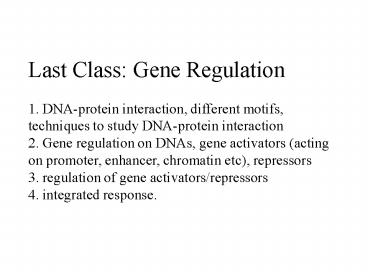Last Class: Gene Regulation 1. DNA-protein interaction, different motifs, techniques to study DNA-protein interaction 2. Gene regulation on DNAs, gene activators (acting on promoter, enhancer, chromatin etc), repressors 3. regulation of gene - PowerPoint PPT Presentation
1 / 45
Title:
Last Class: Gene Regulation 1. DNA-protein interaction, different motifs, techniques to study DNA-protein interaction 2. Gene regulation on DNAs, gene activators (acting on promoter, enhancer, chromatin etc), repressors 3. regulation of gene
Description:
Last Class: Gene Regulation 1. DNA-protein interaction, different motifs, techniques to study DNA-protein interaction 2. Gene regulation on DNAs, gene activators ... – PowerPoint PPT presentation
Number of Views:1022
Avg rating:3.0/5.0
Title: Last Class: Gene Regulation 1. DNA-protein interaction, different motifs, techniques to study DNA-protein interaction 2. Gene regulation on DNAs, gene activators (acting on promoter, enhancer, chromatin etc), repressors 3. regulation of gene
1
Last Class Gene Regulation1. DNA-protein
interaction, different motifs, techniques to
study DNA-protein interaction2. Gene regulation
on DNAs, gene activators (acting on promoter,
enhancer, chromatin etc), repressors3.
regulation of gene activators/repressors4.
integrated response.
2
Posttranscriptional Regulations
3
Posttranscriptional regulation possibilities
4
Alternative RNA Splicing
5
Alternative Splicing of RNA of the Drosophila
DSCAM gene (axon guidance receptors directing
growth cone localization)
6
Negative and Positive Controls of Alternative
Splicing (active regulation)sometimes, the
splicing sequence is ambiguous, so constitutive
random splicing
7
Antibodies (membrane-bound, secreted) in B
lymphocytecleavage regulated RNA processing
(CstF)
8
RNA Editing (inserting Uracil at different sites
and change encoding sequence)
9
Nuclear ExportRev binds to rev response elelent
(RRE), which binds to nuclear export receptor
(exportin 1) to regulate nuclear export even
without splicinga delay of virus infection
symptom
10
Localization in cytoplasmalso determine the fate
of RNAs3 UTR (untranslated region)
11
3 UTR in regulating LocalizationRed intact 3
UTR,Green 3 UTR deleted
12
Translational Regulation
13
Negative Translational Controlaconitase inhibits
ferritin production
14
Phosphorylation RegulationeIF-2B serving as GEF
for eIF-2 and promote translation
initiationphosphorylation locked eIF-2 in
inactive form
15
Internal Ribosome Entry Site (IRES)
16
Two Mechanisms of mRNA decay1. regular 3 tail
shortening followed by 5 decapping and
degradation2. endonucleolytic cleavage and fast
decapping and degrading
17
The competition between mRNA translation and
decayinitiation machinery and deadenylation
proteins are all associated with 5 and 3
18
With Iron, aconitase release enhances the
production of ferritin to bind iron while
destabilizes transferrin receptor mRNA to reduce
the transportation of more iron intracellularly
19
Stop Codon CheckingShould after all the exons
(nonsense-mediated mRNA decaying)
20
SiRNA MechanismRNase, ATP hydrolysis and RNA
helicase
21
Summary
- Premature termination
- Alternative RNA Splicing
- 3 cleavage and Poly A addition
- RNA editing
- Necleus transportation
- Localization of RNA at the cytoplasm
- Translational initiation
- Degradation
22
- Cell Membranes
- Lipid Bilayers
- Cell Membrane
23
Cell Membrane Views
24
Phospholipid Molecule
25
Hydrophilic and Hydrophobic Molecules interacting
differently with water
26
Wedge-shaped lipids form micelles Cylinder-shaped
lipids form bilayers
27
Spontaneous sealing of phospholipid bilayer
28
Liposomes Proved the self sealing process
29
Phospholipid mobility Lateral diffusion
Diffusion coefficient 10-8 cm2/sec Migrate in
seconds to cover the whole surface Flip-Flop
phospholipid translocators
30
Cis-double bonds affect packing Saturated
packed and thick Unsaturated loose and
think Phase transition liquid to fluid
31
Cholesterol and Glycolipids
32
- Function of Cholesterol
- Provide structural support, prevent small
molecule to pass - Prevent tight packing and transition
33
(No Transcript)
34
Phospholipid types
35
Microdomains on plasma membrane Lipid rafts (
50nm) Choresterol Sphingolipids (long saturated
chains) Other proteins
36
Asymmetrical distribution of phospholipids and
glycolipids Protein kinase C (PKC) binds to
negatively charged phosphotidylserine to be
functional
37
Phospholipids in cell signaling
PKC
Calcium
GEF, AKT, migrating front
38
Phospholipase Cleavage sites
39
Phosphotidylserine exposed on outer surface as
apoptosis signal
- Phospholipid translocator
- Scramblase
40
Glycolipids Gm1 Ganglioside with charge can
serve as signal for lipid rafts, binds to Cholera
toxin
41
Summary
- Lipid molecules phospholipids, cholesterol,
glycolipid, all amphipathic - Lipid bilayer, hydrophobic inside and hydrophilic
outside - Subdomains on membrane, asymmetry important for
functions - Phospholipids as signals
42
Membrane Proteins
Integral membrane protein Peripheral membrane
protein
Glycosylphosphatidylinositol (GPI) anchor protein
43
Fatty acid chain (acyl, N-terminal) or prenyl
group modifications (C-terminal)
Or geranylgeranyl
Or palmitic acid
44
Hydropathy Plots Index of hydrophobicity
45
Membrane proteins are glycosylated Sugar are
added in the lumen of the ER and Golgi apparatus,
therefore, sugar are outside of cell
surface Cytosol has reduced environment,
preventing disulfide bonds































